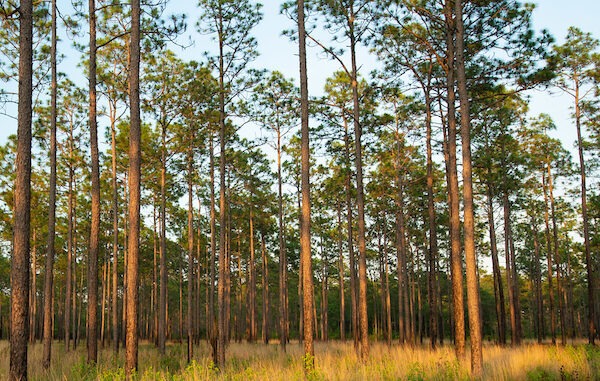
My host insisted we stop the truck, get out and walk around some. I didn’t argue; it was a beautiful day for February, bright and dry, not terribly chill, and if a gentleman staring his 90th year in the eye wanted to walk, I was going to walk.
His stride was steadier than mine is now, and he led me to a longleaf pine that dwarfed the mature white pines on one side, as well as the young longleafs carefully planted in rows on the other.
“Bo, this is a tree,” Mr. Elliot said, almost lovingly patting the bark. “I’ll never see another one like this, and you might not, either.”

He explained that when he was a teenager, that particular tree was the size we would consider harvest ready today. There were some slightly younger longleaf pines, planted when he was a young married farmer, that he would only sell to a boatbuilder for mast timbers. He was on a list of farmers with trees that made candidates for sailboat masts, ironically like the pines that once attracted settlers to the very land where we stood, although now a towering pine was a luxury and a liability more than a crop for a navy that sailed.
Mr. Elliot has long since gone to his final reward, where I hope the pines are always tall and straight and never need a proper burn to rejuvenate the soil. I hope the pines he loved down here have remained, special trees for special customers, and not just been fed into the pulp shredders like so many common loblollies and white pines.
The tree that made Mr. Elliot so proud was a property marker as well as a reminder of a different time. It pleases me to see the return of longleaf pines in so many areas, although I will never see most of them reach full maturity. The producers like the faster growing, short pine trees that replaced the longleafs whose sap was no longer needed, so they went into building thousands upon thousands of homes for soldiers returning from World War II, ready for new homes and new families.
Longleaf pines take decades to produce, and the changes that man has brought on the longleaf belt that once stretched through the South haven’t always been amenable. Machinery and agriculture and construction needs and diaper fluff require more production than can be had from trees that need a century to mature, especially with banks, taxmen, regulators and environmentalists breathing down the necks of the farmers, timbermen and families who depend on trees like their grandfathers depended on corn and tobacco.
There are wide stretches of longleaf pines again, thankfully, that haven’t been chopped and channeled and canaled into submission for subdivisions and highways.
The longleaf produced liquid gold for a time when the world depended on wooden ships: the resin, sap, rosin whatever term you prefer, could be readily gathered and turned into dozens of products from waterproofing compounds and turpentine to cough syrup. A tree was cut and boxed, and as it poured out the sap to heal itself, the thick fluid was caught and sold. It was simple work, but it was hard work – the “piney woods” never produced many millionaires, but they fed a lot of families. Trees that were tapped for too long eventually quit producing, and sometimes became lumber, or sometimes just acted as gigantic lightning rods that brought the healing burns needed by the longleaf forests to thrive.
I had an excited naturalist call me one day years ago after, as the saying goes, a controlled burn went out of control. It had burned a section no one paid any attention to, fire rolling through the area for the first time since a major fire in the 1930s. He was excited, and with good reason.
As the decades of scrub, pine straw and peat burned away and collapsed into ash, they exposed a tiny carnivorous plant that was thought to have been extinct.
It wasn’t as exciting or as sexy as a Venus flytrap, but exposing its dormant seeds to the burned ground and the sunlight produced a bed of the tiny voracious things, which fed on (among other little bugs) midges that can carry diseases to deer. For my caller, it was as exciting as if a paleontologist had discovered a living dinosaur, or an anthropologist had stumbled into a colony of Neanderthals who had never seen homo sapiens.
Those plants lay untouched for years as longleaf pines around them grew, neglected. A chance shift of the wind brought the flames that threatened a nearby building, but that flame resurrected the plants and maybe, just maybe, brought a little relief to the deer and rabbits harassed so unmercifully by the midges.
It always amazed me how God designed things, even things like longleaf forests. Most people look at a pine forest and think it’s devoid of anything except the trees, but a healthy longleaf forest is home to quail, fox squirrels, rabbits, and wild turkeys, as well as the things that want to eat them or the other species that just pass through. Not to mention the bugs that help feed and control the animals, and the plants that help control the bugs. All rely on one another, to some extent. It’s just cool to me how all that works.
While it’s hard to find a completely natural longleaf forest nowadays, just over 200 years ago, Bartram described pines where you could drive a two-horse wagon comfortably between the trees. The weak and spindly trees were starved out or strangled by the thorns and scrub that eventually gave way to the fires that refreshed the soil and allowed the majestic pines to thrive. Now we have folks who carefully nurture the pines, planting them the right distance apart so they have a chance to grow. It’s good to save them, don’t get me wrong, but seeing pine trees lined up like cornstalks bothers some part of me. Still and all, I’d rather have even manicured trees than none at all.
Those old forests – I don’t like using the term old growth, since it sounds pretentious compared to some woods that span a half-millennia – hide secrets, although the mysteries are more from neglect than intent. I have and still use one such mystery, a 1930s era Council axe that I recovered from the roots of a storm-killed tree in Bladen County.
The handle was long since gone, of course, but a new piece of hickory and some sweat brought the piece back to life, more than fifty years after it was purchased and then left or lost by a logger, farmer or Civilian Conservation Corps worker. It works as well now as it did then, a testimony to the folks at Council.
My father sold the same model axe, by the single piece and case, for $1.50 each in the late 1930s; I doubt one he sold in Maryland, Virginia and central North Carolina ended up down here, but how my axe came to be lost, not to mention the man who misplaced a valuable tool, that’s a story that will never be known.
I’ve found other tools as well as remains of turpentine equipment, cars and occasionally forgotten graveyards. Sometimes, although rarely, the wanderer can find an occasional boxfaced longleaf that somehow survived the slow exsanguination of resin, lightning, fires and the hungry sawmills, a battle-scarred warrior that continued to grow until the powdery-sap covered scar was above a tall man’s head. The story of how that tree survived will always be a mystery.
The rusted steel, broken bottles and innumerable, eternally rotting tires all tell stories, too, stories witnessed and kept secret by the tall old trees, evidence only occasionally revealed by a long, slow burn in the pines.
-30-

























